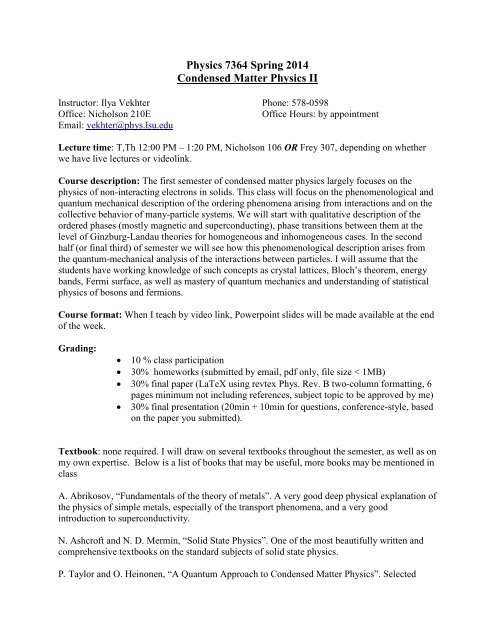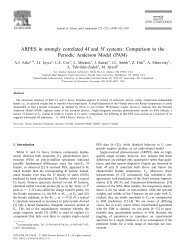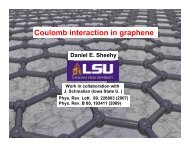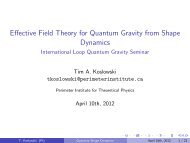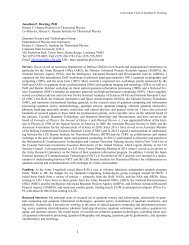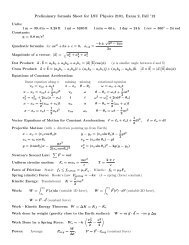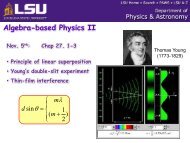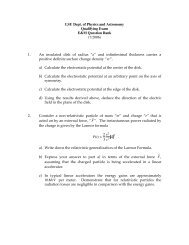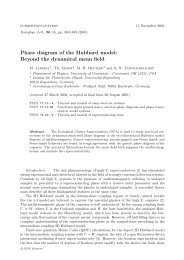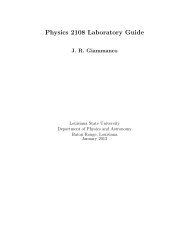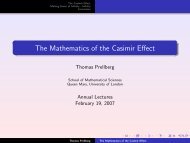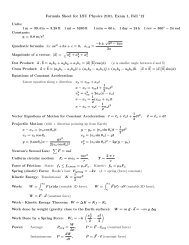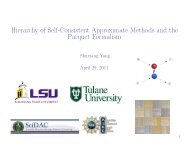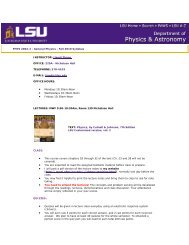available in pdf here
available in pdf here
available in pdf here
Create successful ePaper yourself
Turn your PDF publications into a flip-book with our unique Google optimized e-Paper software.
Physics 7364 Spr<strong>in</strong>g 2014<br />
Condensed Matter Physics II<br />
Instructor: Ilya Vekhter Phone: 578-0598<br />
Office: Nicholson 210E<br />
Office Hours: by appo<strong>in</strong>tment<br />
Email: vekhter@phys.lsu.edu<br />
Lecture time: T,Th 12:00 PM – 1:20 PM, Nicholson 106 OR Frey 307, depend<strong>in</strong>g on whether<br />
we have live lectures or videol<strong>in</strong>k.<br />
Course description: The first semester of condensed matter physics largely focuses on the<br />
physics of non-<strong>in</strong>teract<strong>in</strong>g electrons <strong>in</strong> solids. This class will focus on the phenomenological and<br />
quantum mechanical description of the order<strong>in</strong>g phenomena aris<strong>in</strong>g from <strong>in</strong>teractions and on the<br />
collective behavior of many-particle systems. We will start with qualitative description of the<br />
ordered phases (mostly magnetic and superconduct<strong>in</strong>g), phase transitions between them at the<br />
level of G<strong>in</strong>zburg-Landau theories for homogeneous and <strong>in</strong>homogeneous cases. In the second<br />
half (or f<strong>in</strong>al third) of semester we will see how this phenomenological description arises from<br />
the quantum-mechanical analysis of the <strong>in</strong>teractions between particles. I will assume that the<br />
students have work<strong>in</strong>g knowledge of such concepts as crystal lattices, Bloch’s theorem, energy<br />
bands, Fermi surface, as well as mastery of quantum mechanics and understand<strong>in</strong>g of statistical<br />
physics of bosons and fermions.<br />
Course format: When I teach by video l<strong>in</strong>k, Powerpo<strong>in</strong>t slides will be made <strong>available</strong> at the end<br />
of the week.<br />
Grad<strong>in</strong>g:<br />
• 10 % class participation<br />
• 30% homeworks (submitted by email, <strong>pdf</strong> only, file size < 1MB)<br />
• 30% f<strong>in</strong>al paper (LaTeX us<strong>in</strong>g revtex Phys. Rev. B two-column formatt<strong>in</strong>g, 6<br />
pages m<strong>in</strong>imum not <strong>in</strong>clud<strong>in</strong>g references, subject topic to be approved by me)<br />
• 30% f<strong>in</strong>al presentation (20m<strong>in</strong> + 10m<strong>in</strong> for questions, conference-style, based<br />
on the paper you submitted).<br />
Textbook: none required. I will draw on several textbooks throughout the semester, as well as on<br />
my own expertise. Below is a list of books that may be useful, more books may be mentioned <strong>in</strong><br />
class<br />
A. Abrikosov, “Fundamentals of the theory of metals”. A very good deep physical explanation of<br />
the physics of simple metals, especially of the transport phenomena, and a very good<br />
<strong>in</strong>troduction to superconductivity.<br />
N. Ashcroft and N. D. Merm<strong>in</strong>, “Solid State Physics”. One of the most beautifully written and<br />
comprehensive textbooks on the standard subjects of solid state physics.<br />
P. Taylor and O. He<strong>in</strong>onen, “A Quantum Approach to Condensed Matter Physics”. Selected
subjects covered from the fully quantum viewpo<strong>in</strong>t.<br />
P. Fazekas, “Lecture Notes on Electron Correlations and Magnetism”,<br />
A. Auerbach “Interact<strong>in</strong>g electrons and Quantum Magnetism”,<br />
D. Matthis “Theory of Magnetism”,<br />
L. D. Landau and E. M. Lifshitz, “Electrodynamics of cont<strong>in</strong>uous media”, “Statistical Physics<br />
Vol. 2”<br />
M. T<strong>in</strong>kham, “Introduction to superconductivity”.<br />
P. Phillips, “Advanced Solid State Physics”.<br />
Course website: http://www.phys.lsu.edu/faculty/vekhter/Teach<strong>in</strong>g.html<br />
Topics covered <strong>in</strong> class: We will cover most of the follow<strong>in</strong>g subjects:<br />
• Magnetic systems near the transition. G<strong>in</strong>zburg-Landau expansion.<br />
• G<strong>in</strong>zburg-Landau theories for the first and second order phase transitions.<br />
• G<strong>in</strong>zburg-Landau theories for ferromagnets and antiferromagnets. Doma<strong>in</strong> wall structure.<br />
Magnetization curves. Magnetic anisotropy. Sp<strong>in</strong>-flop transition.<br />
• G<strong>in</strong>zburg-Landau theory of superconductivity: basic phenomena. Flux quantization,<br />
Josephson effect, vortex solutions.<br />
• Derivation of the exchange Hamiltonian <strong>in</strong> <strong>in</strong>sulators. Heisenberg model.<br />
• Magnetism <strong>in</strong> <strong>in</strong>sulators. Sp<strong>in</strong> waves.<br />
• Coulomb <strong>in</strong>teraction and ferromagnetism <strong>in</strong> metallic systems (Stoner <strong>in</strong>stability)<br />
• Electron-phonon <strong>in</strong>teraction<br />
• BCS hamiltonian and microscopic solution for superconductivity<br />
• Towards microscopic description of metallic states: second quantization.<br />
• Screen<strong>in</strong>g, plasma oscillations, Hartree-Fock approximation (if time allows)


